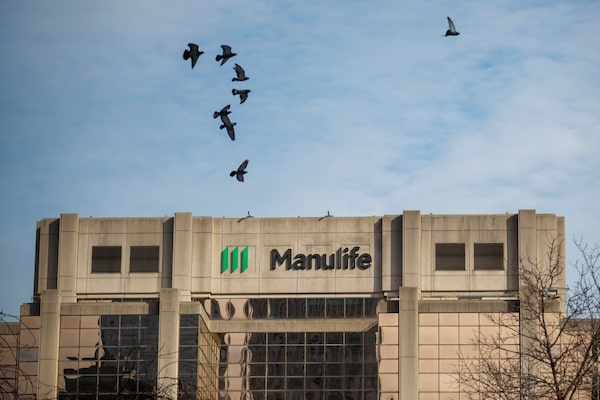
Signage is seen on Manulife Financial Corp.'s office tower in Toronto on Feb. 11, 2020.Cole Burston/The Canadian Press
Manulife Financial Corp. recorded big gains in profits from U.S. operations in the second quarter as large numbers of its long-term care customers died and stopped making insurance claims.
Manulife said Thursday it had US$100-million in gains in its U.S. long-term care business. The company’s chief actuary, Steven Finch, told analysts on an conference call that “the biggest driver of that” was deaths of people receiving care in long-term facilities who “were disproportionately impacted by the virus.” Deaths among Manulife’s long-term care customers were up more than 25 per cent over normal, he said.
Despite those gains and others, the company’s overall net income for the second quarter ended June 30 declined by 52 per cent compared with the same period last year, to $684-million.
In addition to reduced long-term care claims because of deaths, claims from the living also declined, either from customers leaving long-term care facilities or not receiving home-care visits. But Manulife believes both of those trends “are just a delay in claims – people need the care,” Mr. Finch said. So, the company created a $100-million reserve for future claims.
Offsetting the benefit from those lower claims, the United States also made up “the vast majority” of Manulife’s $36-million in life insurance policy payouts for COVID-19 deaths, Mr. Finch said.
Still, the country was Manulife’s best-performing geographic segment in the second quarter, with a 32-per-cent gain in profits.
In past crises, such as the meltdown of 2008-09, wild swings in financial markets hit insurers in their investment portfolios. That’s still true, and Manulife said it recorded an $800-million charge to the value of its investments, which helped cut the company’s net income by more than half.
With a pandemic such as COVID-19, however, the insurers’ normal business of premiums received and claims paid out is also sharply disrupted.
Manulife’s new business value – a measure of new insurance policies sold – fell 22 per cent in the second quarter from the prior year.
The major insurers – and the analysts who follow them – emphasize versions of earnings that strip out investment losses and make other accounting adjustments. What Manulife calls its “core” earnings were $1.56-billion, up 5 per cent from the prior-year period, and well ahead of analysts’ expectations.
The core number excluded a $916-million loss on investments, largely driven by an $800-million writedown of the value of some of Manulife’s long-term assets, such as real estate, private equity and oil and gas holdings. Stock market gains in the second quarter were offset by the negative impact of low interest rates.
Sun Life Financial Inc., which reported earnings late Thursday, said it had $187-million in market-related losses outside of its underlying earnings, driven by changes in interest rates.
“We have taken significant action over the last decade to reduce the risk to our franchise and reduce the sensitivity to market movements,” Manulife CEO Roy Gori said in an interview with The Globe and Mail before Thursday’s analyst call, during which Manulife discussed its long-term care business. “The sensitivity to interest rates today is about one-10th of what it was about a decade ago. The sensitivity to equity markets is about one-half of what it was a decade ago,” he said.
Mr. Gori said Manulife is three years ahead of schedule in its goals for improving its capital levels, and plans to hit cost-savings targets next year, two years ahead of a 2022 goal. “We are certainly living in unprecedented and challenging times, but I feel very confident about the company’s ability to navigate the challenges and to come through in good shape.”
Our Morning Update and Evening Update newsletters are written by Globe editors, giving you a concise summary of the day’s most important headlines. Sign up today.